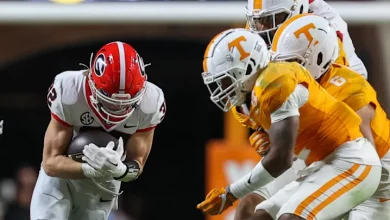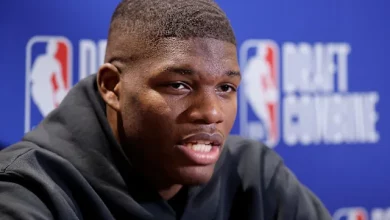Sooners freshman catcher Corri Hicks has entered the transfer portal, signaling a notable departure from Oklahoma’s talented softball roster.

The Oklahoma Sooners softball program has long been a powerhouse in collegiate softball, known for recruiting elite talent and maintaining a competitive edge under the leadership of legendary coach Patty Gasso. Recently, the program faced a notable change with freshman catcher Corri Hicks entering the NCAA transfer portal. This development has sparked interest and speculation about Hicks’ future, the reasons behind her decision, and its impact on Oklahoma softball’s outlook.
Early Promise: Corri Hicks’ Background and Recruitment
Corri Hicks arrived at the University of Oklahoma with high expectations. A standout catcher from Archbishop Mitty High School in San Jose, California, Hicks earned multiple accolades during her high school career. She was named the 2024 West Catholic Athletic League Player of the Year and a three-time CalHiSports All-State honoree. Known for her powerful bat and defensive skills behind the plate, Hicks posted impressive stats throughout high school. As a sophomore, she batted .398, hitting 13 home runs and driving in 42 RBIs, showcasing a rare combination of power and consistency. Even in her senior year, Hicks maintained a solid .302 batting average with six home runs and 16 RBIs.
Hicks also gained exposure and further honed her skills playing travel ball with the Orange County Batbusters, a highly respected program known for producing collegiate and professional talent. Her performance in high school and club softball earned her a place in Oklahoma’s 2024 recruiting class, one of the top classes in the country, and a testament to the Sooners’ reputation for attracting premier athletes.
Coach Patty Gasso, who has guided Oklahoma to multiple national championships, highlighted Hicks as a player with the potential to “change a game with a single swing,” reflecting the high ceiling the coaching staff saw in her.
Freshman Year Challenges and Limited Playing Time
Transitioning from high school to Division I softball is notoriously challenging. Hicks entered the 2024-2025 season ready to make an impact but quickly faced obstacles. Early on, she missed some fall practice time due to injury, which slowed her acclimation to the speed and physicality of the college game. Although she returned to full health, breaking into a starting role proved difficult.
At Oklahoma, Hicks found herself behind Isabela Emerling, a transfer from North Carolina who secured the starting catcher role. Emerling brought experience and consistent production, limiting Hicks’ playing opportunities. Over the course of the season, Hicks primarily served as a backup, receiving spot starts and late-inning appearances. While she displayed flashes of her potential at the plate and behind the plate, the limited playing time left her eager for a larger role.
The Sooners’ team dynamic also factored into Hicks’ experience. Oklahoma boasts a deep and talented roster, with a competitive environment that can be both motivating and challenging for young players. Adjusting to new teammates, coaching expectations, and academic pressures adds to the complexity of a freshman athlete’s first year.
Entering the Transfer Portal: What It Means
On June 4, 2025, Corri Hicks officially entered the NCAA transfer portal. The transfer portal, established in 2018, has revolutionized college athletics by allowing players to explore transfer options more freely. Players can communicate with other schools and seek new opportunities without penalty, making transfers more common across all sports.
Hicks’ decision to enter the portal is significant for several reasons:
1. Seeking More Playing Time and Development
The most common reason players enter the transfer portal is the pursuit of increased playing time. For Hicks, the chance to be a backup to an experienced starter may have limited her development and exposure on the field. By transferring, Hicks can find a program where she can start regularly, showcase her skills, and continue growing as a player.
This is particularly important for catchers, a position that requires experience and confidence to command a pitching staff and contribute offensively. A starting role elsewhere can accelerate Hicks’ growth, improve her visibility for potential professional or national team opportunities, and boost her overall career trajectory.
2. Finding the Right Fit
Beyond playing time, transfers often occur due to a desire for a better cultural or academic fit. Players sometimes find that a program’s style of coaching, team dynamics, or campus environment doesn’t align with their needs or personality. A fresh start can help athletes thrive both on and off the field.
While Oklahoma offers an elite program, its competitive culture may not have been the right match for Hicks at this stage in her career. Finding a new home where she feels more comfortable and supported could be critical for her long-term success.
3. The Evolution of College Athletics
The transfer portal has increased player mobility, allowing athletes more freedom to control their destinies. This has led to a more dynamic landscape where roster changes are common, even in top programs. Hicks’ move reflects this evolving reality, emphasizing the importance of flexibility for both players and programs.
Impact on the Oklahoma Sooners Softball Program
For Oklahoma, Hicks’ departure marks a loss of promising young talent but is unlikely to drastically alter the program’s trajectory. The Sooners have a deep roster of highly recruited players and a strong pipeline of future talent. Coach Gasso’s staff is well-known for developing players and adapting to roster changes.
Roster Depth and Recruiting
Oklahoma will continue to rely on emerging catchers within their program and ongoing recruitment efforts to fill any gaps. The Sooners’ status as a top program helps attract elite talent annually, ensuring depth at key positions.
Maintaining a Competitive Edge
Despite individual departures, Oklahoma softball remains a national contender. The program’s resilience and culture of winning mean it can weather transfers while staying competitive in the highly competitive SEC and NCAA tournament landscape.
What’s Next for Corri Hicks?
The next step for Hicks is identifying a program where she can maximize her potential. As a talented catcher with a strong high school pedigree, she will likely receive interest from multiple schools seeking to bolster their rosters with a capable backstop.
Her future success will depend on:
- Choosing a Program: Finding a team where she can earn a starting role and develop her skills.
- Staying Healthy: Avoiding injuries and maintaining fitness to perform consistently.
- Mental and Emotional Fit: Joining a supportive environment that nurtures her growth as an athlete and student.
The softball community will watch closely to see where Hicks lands and how she develops in the coming seasons.
Corri Hicks’ decision to enter the transfer portal highlights the fluid nature of college athletics today. For a talented freshman catcher like Hicks, the move represents a quest for greater opportunity, playing time, and the right environment to thrive.
While Oklahoma softball loses a promising player, the program’s strength and depth mean it will continue to compete at the highest levels. Meanwhile, Hicks embarks on a new chapter, with the chance to define her collegiate career on her own terms.
Her story is a reminder of the challenges and choices student-athletes face and the ongoing evolution of college sports in the transfer portal era.









